Celtic mythology, a tapestry rich in legends and folklore, forms an integral part of the ancient Celtic culture that flourished across Europe. Among its pantheon of deities, Epona holds a distinctive place as a revered goddess. Epona, celebrated across various Celtic tribes, is primarily honored as the goddess of horses, an embodiment of fertility and sovereignty. Her unique significance stems not only from her association with these majestic creatures but also from her influence that transcended the boundaries of Celtic realms, finding a place in Roman worship as well. This article delves into the mystique of Epona, exploring her historical roots, symbolic importance, and enduring legacy in the Celtic mythological tradition.
| Attribute | Epona Information |
|---|---|
| Origin | Celtic Mythology |
| Deity Type | Goddess of Horses and Fertility |
| Role | Goddess associated with horses, fertility, and agriculture |
| Horse Symbolism | Often depicted riding or accompanied by horses, symbolizing her connection to these animals |
| Cultural Impact | Revered as a symbol of equine and agricultural aspects of Celtic culture |
| Depictions | Featured in Celtic art and folklore, often as a benevolent and protective goddess |
1. Historical Origins and Worship of Epona
Tracing Epona’s Roots in Celtic Mythology
The Celts, flourishing across Europe during the Iron Age, trace Epona’s historical roots in Celtic mythology. The Celts revered Epona, deeply intertwining her origins with their affinity for horses. Horses, vital not only for warfare and transportation but also holding a sacred place in Celtic society, were central. Epona, often depicted as a protector and nurturer, symbolized this profound reverence for horses. Her name, believed to derive from the Gaulish word for horse (‘epos’), underlines her intrinsic connection to these animals.
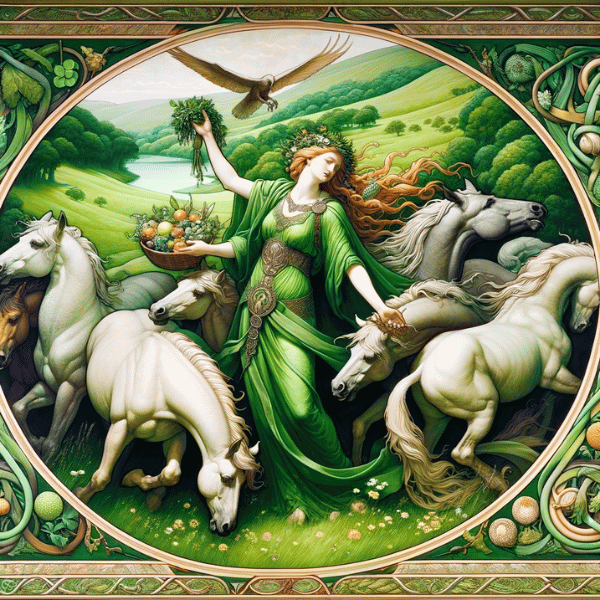
Archaeological Footprints of Epona’s Worship
Various archaeological findings vividly illustrate the worship of Epona, as researchers have unearthed inscriptions, statues, and reliefs dedicated to her across Celtic regions, providing tangible evidence of her veneration. These artifacts, often found in regions like Gaul (modern-day France and parts of Central Europe), depict Epona in various forms – sometimes riding a horse, other times surrounded by foals, symbolizing fertility and abundance. These relics not only highlight her importance in Celtic religion but also offer insights into the artistic expressions of the era.
Epona’s Influence Beyond the Celtic Realm
Remarkably, Epona’s veneration was not confined to the Celtic world; her worship permeated the Roman Empire. This cross-cultural adoption, especially during the Roman conquest of Celtic territories, is a testament to her widespread appeal and significance. In Roman society, they embraced Epona as a protector of cavalry and equestrians, a role that resonated with the Romans’ esteemed view of horses. They marked annual celebrations in her honor, such as the festival of Eponalia, on the Roman calendar, which bestowed a rare honor upon a deity of foreign origin. This assimilation illustrates not just the blending of cultures but also the enduring power and appeal of Epona’s persona across different civilizations.
2. Symbolism and Iconography of Epona
Epona’s Associated Symbols
Epona, in Celtic mythology, is intricately associated with several symbols, each reflecting different aspects of her divine attributes. The most prominent of these is the horse, embodying strength, freedom, and a deep connection with nature. Alongside this, she is often depicted with a cornucopia, symbolizing abundance and fertility, and keys, indicating her role as a guardian and a guide to the afterlife. These symbols, found in various artifacts, offer a multifaceted view of Epona, portraying her as a nurturing, protective, and prosperous deity.
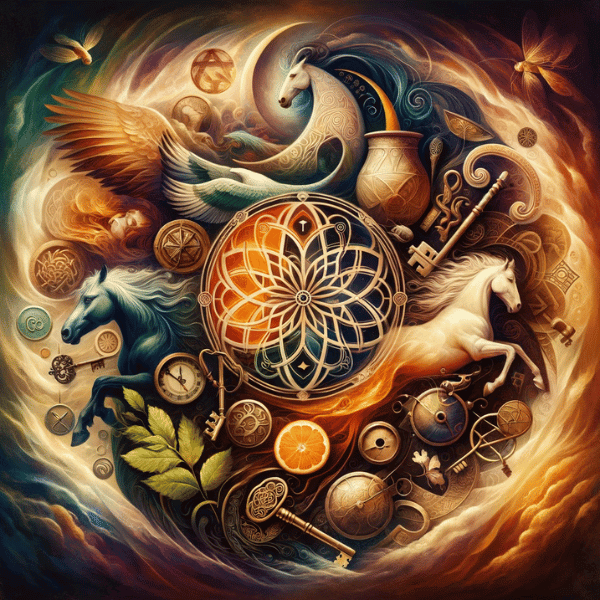
Deciphering Epona’s Iconography
The iconography of Epona in Celtic and Roman artifacts provides a rich tapestry of interpretation. Statues and reliefs often depict her seated or riding a horse, emphasizing her role as a horse protector and a symbol of sovereignty and travel. The presence of foals in her imagery reinforces her association with fertility and caretaking. Additionally, Epona is sometimes shown holding a cornucopia, signifying her as a benevolent provider. These artistic representations not only portray her divine functions but also reflect the societal values and beliefs of the time.
The Horse in Celtic Culture and its Connection to Epona
In Celtic culture, the horse holds a place of high esteem, symbolizing a range of qualities from power and nobility to spiritual guidance. This reverence is deeply woven into the fabric of their mythology and day-to-day life. Epona, as the embodiment of the horse’s spirit, represents this profound cultural significance. She is not just a deity overseeing the physical aspects of horses but also a spiritual guide, leading souls in their afterlife journey. The horse’s symbolism in Celtic culture, thus, extends beyond the physical realm, intertwining with Epona’s divine essence in a symbiosis of spiritual and earthly significance.
3. Epona’s Role in Celtic Society and Religion
Reverence in Daily Life and Rituals
Epona’s presence in Celtic society extended beyond mythological narratives, influencing everyday life and religious practices. She was revered not only as a goddess of horses but also as a guardian of livelihood and prosperity. In a society where horses were integral to survival and success, Epona’s veneration became a part of daily rituals. Her statues and symbols were common in stables and farms, serving as a protective charm for the animals and the people who depended on them. Celtic rituals, especially those related to agriculture and fertility, often invoked Epona’s blessings for bountiful harvests and the wellbeing of livestock.
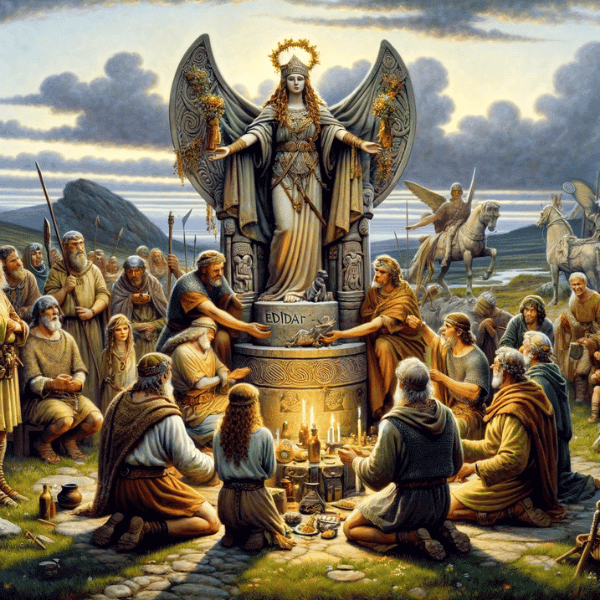
Impact on Societal Values: Fertility and Protection
Epona’s influence profoundly shaped Celtic societal values, particularly around concepts of fertility and protection. Epona, a fertility deity, bestowed abundance and ensured the continuation of life cycles, encompassing agriculture, animal fertility, and human fertility, while embodying nurturing aspects of motherhood and caretaking in human communities.
Protection, another key aspect of Epona’s influence, is evident in her depiction as a guardian figure. In a society where external threats and the harshness of nature were constant concerns, Epona’s role as a protector was immensely significant. She was seen as a safeguard against adversities, not just for horses but for the entire community. This aspect of her worship reflects the Celtic respect for and reliance on divine protection in their challenging environment.
4. Epona’s Legacy in Modern Culture
Epona in Contemporary Art
Epona’s legacy transcends the boundaries of ancient mythology, finding resonance in modern literature, art, and popular culture. She often appears as a symbol of freedom and nature’s untamed spirit in literary works, resonating with contemporary themes of ecological awareness and personal growth. In visual arts, artists depict Epona in various forms, ranging from traditional interpretations to abstract representations, reflecting her enduring influence as a symbol of grace and power. In popular culture, references to Epona appear in movies, television shows, and even video games, showcasing her as a figure of mystique and inspiration, often linked to themes of adventure and exploration.
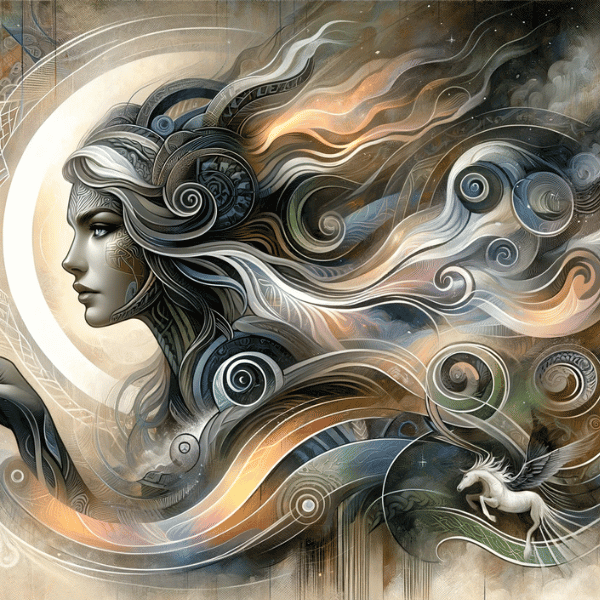
The Revival of Interest in Celtic Deities
The modern era has seen a revival in the interest in Celtic deities, including Epona, driven by a growing fascination with ancient cultures and spirituality. Neo-paganism and Celtic spirituality demonstrate this resurgence by revering Epona as a powerful embodiment of nature and femininity. The revival has also sparked academic and historical interest, leading to more research and publications exploring Celtic mythology and its deities. This renewed interest not only brings to light forgotten myths but also offers new interpretations and understandings of these ancient figures.
Epona’s Contribution to Celtic Heritage
Epona’s enduring legacy significantly contributes to the contemporary understanding of Celtic heritage. Her story and symbolism provide insights into the ancient Celtic worldview, highlighting their deep connection with nature, animals, and the spiritual realm. Epona, as a bridge between the ancient and modern worlds, helps in keeping the Celtic heritage alive, allowing modern audiences to appreciate and learn from the rich tapestry of Celtic mythology and culture. Her continued relevance in modern times serves as a testament to the timeless nature of mythological narratives and their ability to transcend cultural and temporal boundaries.
5. Comparative Analysis with Other Horse Deities
Epona and Greek Horse Deities
Epona’s role in Celtic mythology finds interesting parallels and contrasts with horse deities in Greek mythology, such as Poseidon and Demeter. Poseidon, known as the god of the sea, earthquakes, and horses, shares with Epona the dominion over horses. However, while Epona is primarily a nurturing and protective figure, Poseidon’s association with horses also encompasses the untamed and formidable aspects of nature. Demeter, like Epona, associates herself with fertility and the earth, but her influence extends beyond, embracing agricultural abundance as a whole, rather than being horse-specific.
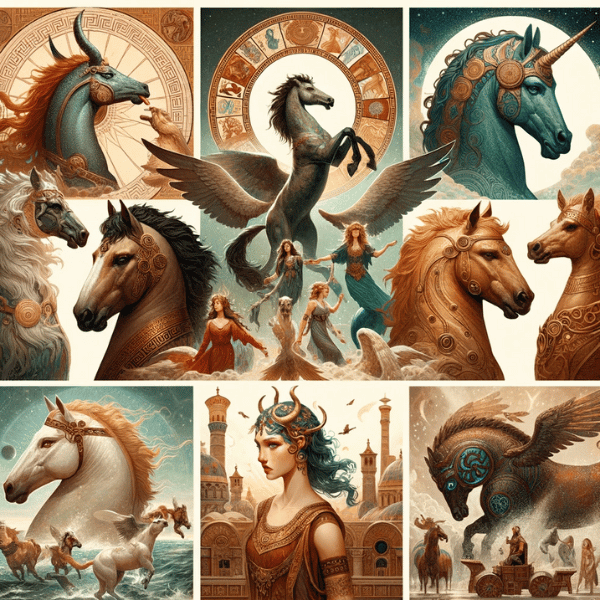
Epona and Norse Horse Deities
In Norse mythology, the horse holds a significant place, with deities like Odin and Freyja having strong equine associations. Odin’s steed, Sleipnir, is a prominent figure, symbolizing strength, speed, and transcendence. While Sleipnir is more a companion to a deity rather than a deity itself, the importance of horses in Norse culture echoes that in Celtic traditions. Freyja, akin to Epona, embodies femininity and fertility, but her connection with horses is less direct compared to Epona’s.
Cultural Perspectives on Horses and Their Deities
The comparison of Epona with Greek and Norse horse deities highlights differing cultural perspectives on horses and their divine representations. In Celtic culture, people revere the horse as they symbolize fertility, prosperity, and protection, closely connecting them to daily life and spirituality, with Epona embodying these attributes. In Greek mythology, the horse symbolizes power and natural forces, with a more formidable aspect in deities like Poseidon. Norse mythology presents horses as companions of the gods, symbolizing strength and mystical qualities.
Conclusion
Epona, the Celtic goddess of horses, emerges as a profound symbol in ancient mythology, embodying fertility, protection, and sovereignty. She highlights her unique significance through her deep connection with horses, reflecting the Celtic reverence for these creatures as symbols of life and spirit. The archaeological evidence and rich iconography surrounding Epona underscore her pervasive influence in both Celtic and Roman cultures. In modern times, Epona’s legacy continues to resonate, finding expression in literature, art, and a renewed interest in Celtic spirituality. Her enduring appeal in contemporary culture underscores not only the timeless nature of mythological narratives but also the significant role such deities play in connecting us with our ancient heritage, offering insights into the values, beliefs, and practices of the Celts that continue to fascinate and inform our understanding of human history and spirituality.
